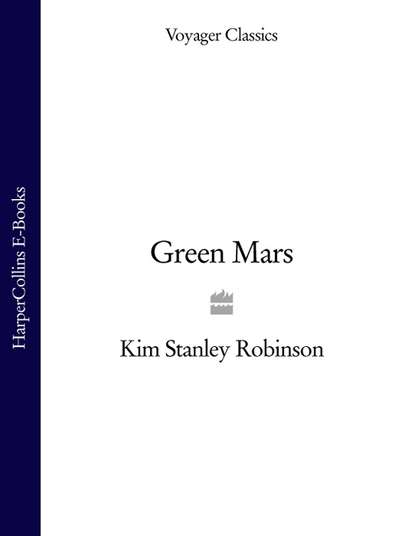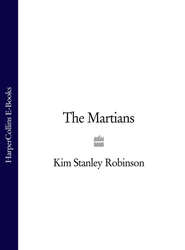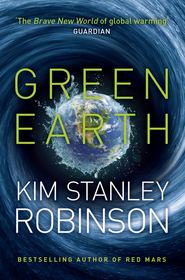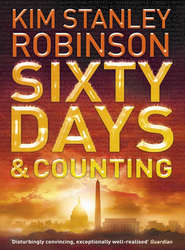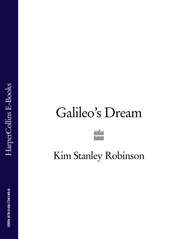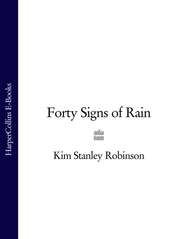По всем вопросам обращайтесь на: info@litportal.ru
(©) 2003-2024.
✖
Green Mars
Автор
Год написания книги
2018
Настройки чтения
Размер шрифта
Высота строк
Поля
Ann drove east along the southern rim of Marineris, until she was between Nirgal Vallis and the Aureum Chaos. She stopped to resupply at the refuge called Dolmen Tor, which was where Michel and Kasei had taken them at the end of their retreat down Marineris, in 2061. Seeing the little refuge again did not affect her; she scarcely remembered it. All her memories were going away, which she found comforting. She worked at it, in fact, concentrating on the moment with such intensity that even the moment itself went away, every moment a burst of light in a fog, like things breaking in her head.
Certainly the trough predated the chaos and the outbreak channels, which were no doubt located there because of the trough. Tharsis had been a tremendous source of outgassing, all the radial and concentric fractures around it leaking volatiles out of the hot centre of the planet. Water in the regolith had run downhill, into the depressions on each side of the bulge. It could be that the depressions were the direct result of the bulge, simply a matter of the lithosphere bent down on the outskirts of where it had been pushed up. Or it could be that the mantle had sunk underneath the depressions, as it had plumed under the bulge. Standard convection models would support such an idea—the upwelling of the plume had to go back down somewhere, after all, rolling at its sides and pulling the lithosphere down after it.
And then, up in the regolith, water had run downhill in its usual way, pooling in the troughs, until the aquifers burst open, and the surface over them collapsed: thus the outbreak channels, and the chaos. It was a good working model, plausible and powerful, explaining a lot of features.
So every day Ann drove and then walked, seeking confirmation of the mantle convection explanation for the Chryse trough, wandering over the surface of the planet, checking old seismographs and picking away at rocks. It was hard now to make one’s way north in the trough; the aquifer outbreaks of 2061 nearly blocked the way, leaving only a narrow slot between the eastern end of the great Marineris glacier, and the western side of a smaller glacier that filled the whole length of Ares Vallis. This slot was the first chance east of Noctis Labyrinthus to cross the equator without going over ice, and Noctis was six thousand kilometres away. So a piste and a road had been built in the slot, and a fairly large tent town established on the rim of Galilaei Crater. South of Galilaei the narrowest part of the slot was only forty kilometres wide, a zone of navigable plain located between the eastern arm of the Hydaspis Chaos and the western part of Aram Chaos. It was hard to drive through this zone and keep the piste and road under the horizons, and Ann drove right on the edge of Aram Chaos, looking down onto the shattered terrain.
North of Galilaei it was easier. And then she was out of the slot, and onto Chryse Planitia. This was the heart of the trough, with a gravitational potential of –0.65; the lightest place on the planet, lighter even than Hellas and Isidis.
But one day she drove onto the top of a lone hill, and saw that there was an ice sea out in the middle of Chryse. A long glacier had run down from Simud Vallis, and pooled in the Chryse low point, spreading until it became an ice sea, covering the land over the horizons to north, northeast, northwest. She drove slowly around its western shore, then its northern shore. It was some two hundred kilometers across.
Near the end of one day she stopped her car on a ghost crater rim, and stared out across the expanse of broken ice. There had been so many outbreaks in ’61. It was clear that there had been some good areologists working for the rebels, finding aquifers and setting off explosions or reactor meltdowns precisely where the hydrostatic pressures were the greatest. Using a lot of her own findings, it seemed.
But that was the past, banished now. All that was gone. Here and now, there was only this ice sea. The old seismographs she had picked up all had records disturbed by recent tremblors from the north, where there should have been very little activity. Perhaps the melting of the northern polar cap was causing the lithosphere there to rebound upward, setting off lots of small marsquakes. But the tremblors recorded by the seismographs were discrete short-period shocks, like explosions. She had studied her car’s AI screen through many a long evening, mystified.
Every day she drove, then walked. She left the ice sea, and continued north onto Acidalia.
The great plains of the northern hemisphere were generally referred to as level, and they certainly were compared to the chaoses, or to the southern highlands. But still, they were not level like a playing field, or a table top—not even close. There were undulations everywhere, a continuous up-and-downing of hummocks and hollows, ridges of cracking bedrock, hollows of fine drifts, great rumpled boulder fields, isolated tors and little sinkholes … It was unearthly. On Earth, soil would have filled the hollows, and wind and water and plant life would have worn down the bare hilltops, and then the whole thing would have been submerged or subducted or worn flat by ice sheets, or uplifted by tectonic action, everything torn away and rebuilt scores of times as the eons passed, and always flattened by weather and biota. But these ancient corrugated plains, their hollows banged out by meteor impact, had not changed for a billion years. And they were among the youngest surfaces on Mars.
It was a hard thing to drive across such lumpy terrain, and very easy to get lost when out walking, particularly if one’s car looked just like all the other boulders scattered about; particularly if one were distracted. More than once Ann had to find the car by radio signal rather than visual sighting, and sometimes she walked right up to it before recognising it—and then would wake up, or come to, hands shaking in the aftershock of some forgotten reverie.
The best driving routes were along the low ridges and dikes of exposed bedrock. If these high basalt roads had connected one to the next, it would have been easy. But they commonly were broken by transverse faults, at first no more than line cracks, which then got deeper and wider as one progressed, in sequences like loaves of sliced bread tipping open, until the faults gaped and were filled with rubble and fines, and the dike became nothing but part of a boulder field again.
She continued north, onto Vastitas Borealis. Acidalia, Borealis: the old names were so strange. She was doing her best never to think, but during the long hours in the car it was sometimes impossible. At those times it was less dangerous to read than it was to try staying blank. So she would read randomly in her AI’s library. Often she ended up staring at areological maps, and one evening at sunset after such a session, she looked into this matter of Mars’s names.
It turned out most of them came from Giovanni Schiaparelli. On his telescope maps he had named over a hundred albedo features, most of which were just as illusory as his canali. But when the astronomers of the 1950s had regularised a map of the albedo features everyone could agree on—features that could be photographed—many of Schiaparelli’s names had been retained. It was a tribute to a certain power he had had, a power evocative if not consistent; he had been a classical scholar, and a student of Biblical astronomy, and among his names there were Latin, Greek, Biblical, and Homeric references, all mixed together. But he had had a good ear, somehow. One proof of his talent was the contrast between his maps and competing Martian maps of the nineteenth century. A map by an Englishman named Proctor, for instance, had relied on the sketches of a Reverend William Dawes; and so on Proctor’s Mars, which had no recognisable relations even to the standard albedo features, there was a Dawes Continent, a Dawes Ocean, a Dawes Strait, a Dawes Sea, and a Dawes Forked Bay. Also an Airy Sea, a DeLaRue Ocean, and a Beer Sea. Admittedly this last was a tribute to a German named Beer, who had drawn a Mars map even worse than Proctor’s. Still, compared to them Schiaparelli had been a genius.
But not consistent. And there was something wrong in this mélange of references, something dangerous. Mercury’s features were all named after great artists, Venus’s were named after famous women; they would drive or fly over those landscapes one day, and feel that they lived in coherent worlds. Only on Mars did they walk about in a horrendous mishmash of the dreams of the past, causing who knew what disastrous misapprehensions of the real terrain: the Lake of the Sun, the Plain of Gold, the Red Sea, Peacock Mountain, the Lake of the Phoenix, Cimmeria, Arcadia, the Gulf of Pearls, the Gordian Knot, Styx, Hades, Utopia …
On the dark dunes of Vastitas Borealis she began to run low on supplies. Her seismographs showed daily tremblors to the east, and she drove toward them. On her walks outside she studied the garnet sand dunes, and their layering which revealed the old climates like tree rings. But snow and high winds were tearing off the crests of the dunes. The westerlies could be extremely strong, enough to pick up sheets of large-grained sand and hurl them against her car. The sand would always settle in dune formations, as a simple matter of physics, but the dunes would be picking up the pace of their slow march around the world, and the record they had made of earlier ages would be destroyed.
She forced that thought from her mind, and studied the phenomenon as if there were no new artificial forces disturbing it. She focused on her work as if clenching her geologist’s hammer, as if breaking apart rocks. The past was spalled away piece by piece. Leave it behind. She refused to think of it. But more than once she jerked out of sleep with the image of the long runout coming at her. And then she was awake for good, sweating and trembling, faced with the incandescent dawn, the sun blazing like a chunk of burning sulphur.
Coyote had given her a map of his caches in the north, and now she came to one buried in a cluster of house-sized boulders. She restocked, leaving a brief thank-you note. The last itinerary Coyote had given her said he was going to be dropping by this area sometime soon, but there was no sign of him, and no use waiting. She drove on.
She drove, she walked. But she couldn’t help it; the memory of the landslide haunted her. What bothered her was not that she had had a brush with death, which no doubt had happened many times before, mostly in ways she had not noticed. It was simply how arbitrary it had been. It had nothing to do with value or fitness; it was pure contingency. Punctuated equilibrium, without the equilibrium. Effects did not follow from causes, and one did not get one’s just deserts. She was the one who had spent too much time outdoors, after all, taking on far too much radiation; but it was Simon who had died. And she was the one who had fallen asleep at the wheel; but it was Frank who had died. It was simply a matter of chance, of accidental survival or erasure.
It was hard to believe natural selection had made any way in such a universe. There under her feet, in the troughs between the dunes, Archae bacteria were growing on sand grains; but the atmosphere was gaining oxygen fast, and all the Archae bacteria would die out except those that were by accident underground, away from the oxygen they themselves had respired, the oxygen that was poisonous to them. Natural selection or accident? You stood, breathing gases, while death rushed toward you—and were covered by boulders, and died—or covered by dust, and lived. And nothing you did mattered in that great either/or. Nothing you did mattered. One afternoon, reading randomly in the AI to distract herself between her return to the car and her dinner hour, she learned that the Czarist police had taken Dostoevsky out to be executed, and only brought him back in after several hours of waiting for his turn. Ann finished reading about this incident and sat in the driver’s seat of her car, feet on the dash, staring at the screen blindly. Another garish sunset poured through the window over her, the sun weirdly large and bright in the thickening atmosphere. Dostoevsky had been changed for life, the writer declared in the easy omniscience of biography. An epileptic, prone to violence, prone to despair. He hadn’t been able to integrate the experience. Perpetually angry. Fearful. Possessed.
Ann shook her head and laughed, angry at the idiot writer, who simply didn’t understand. Of course you didn’t integrate the experience. It was meaninglessness. The experience that couldn’t be integrated.
The next day a tower poked over the horizon. She stopped the car, stared at it through the car’s telescope. There was a lot of ground mist behind it. The tremblors registering on her seismograph were very strong now, and appeared to be coming from a bit to the north. She even felt one of them herself, which, given the car’s shock absorbers, meant they were strong indeed. It seemed likely there was a connection with the tower.
She got out of her car. It was almost sunset, the sky a great arch of violent colours, the sun low in the hazy west. The light would be behind her. She wound between dunes, then carefully made her way to the crest of one, and crawled the final metres of the way, and looked over the crest at the tower, now only a kilometre to the east. When she saw how close its base was she kept her chin right on the ground, among ejecta the size of her helmet.
It was some kind of mobile drilling operation, a big one. The massive base was flanked by giant caterpillar tracks, like those used to move the largest rockets around a spaceport. The drill tower rose out of this behemoth more than sixty metres, and the base and lower part of the tower clearly contained the technicians’ housing and equipment and supplies.
Beyond this thing, a short distance down a gentle slope to the north, was a sea of ice. Immediately north of the drill, the crests of the great barchan dunes still stuck out of the ice—first as a bumpy beach, then as hundreds of crescent islands. But a couple of kilometres out the dune crests disappeared, and it was ice only.
The ice was pure, clean—translucent purple under the sunset sky—clearer than any ice she had ever seen on the Martian surface, and smooth, not broken like all the glaciers. It was steaming faintly, the frost steam whipping east on the wind. And out on it, looking like ants, people in walkers and helmets were ice-skating.
It had come clear the moment she saw the ice. Long ago she herself had confirmed the big impact hypothesis, which accounted for the dichotomy between the hemispheres; the low smooth northern hemisphere was simply a superhuge impact basin, the result of a scarcely imaginable collision in the Noachian, between Mars and a planetesimal nearly as big as it. The rock of the impact body that had not vaporised had become part of Mars itself, and there were arguments in the literature that the irregular movements in the mantle which had caused the Tharsis bulge were late developments resulting from perturbations originating with the impact. To Ann that wasn’t likely, but what was clear was that the great crash had happened, wiping out the surface of the entire northern hemisphere, and lowering it by an average of four kilometres relative to the south. An astonishing hit, but that was the Noachian. An impact of similar magnitude had in all probability caused the birth of Luna out of Earth. In fact there were some anti-impact holdouts arguing that if Mars had been hit as hard, it should have had a moon as big.
But now, lying flat looking at the giant drilling rig, the point was that the northern hemisphere was even lower than it first appeared, for its bedrock was amazingly deep, as much as five kilometres beneath the dunes. The impact had blown that deep, and then the depression had mostly refilled, with a mixture of ejecta from the big impact, windblown sand and fines, later impact material, erosional material sliding down the slope of the Great Escarpment, and water. Yes, water, finding the lowest point as it always did; the water in the annual frost hood, and the ancient aquifer outbreaks, and the outgassing from the blistered bedrock, and the lensing from the polar cap, had all eventually migrated to this deep zone, and combined to form a truly enormous underground reservoir, an ice and liquid pool that extended in a band all the way around the planet, underlying almost everything north of 60°north latitude, except, ironically, for a bedrock island on which the polar cap itself stood.
Ann had discovered this underground sea many years before, and by her estimates between sixty and seventy percent of all the water on Mars was down there. It was, in fact, the Oceanus Borealis that some terraformers talked about—but buried, deeply buried, and mostly frozen, and mixed with regolith and dense fines; a permafrost ocean, with some liquid down on the deepest bedrock. All locked down there for good, or so she had thought, because no matter how much heat the terraformers applied to the planet’s surface, the permafrost ocean would not thaw any faster than a metre per millennium—and even when it did melt it would remain underground, simply as a matter of gravity.
Thus the drilling rig before her. They were mining the water. Mining the liquid aquifers direct, and also melting the permafrost with explosives, probably nuclear explosives, and then collecting the melt and pumping it onto the surface. The weight of the overlying regolith would help push the water up through pipes. The weight of water on the surface would help push up more. If there were very many drilling rigs like this one, they could put a tremendous amount on the surface. Eventually they would have a shallow sea. An ice sea to start with, but between atmospheric warming, sunlight, bacterial action, increased winds—it would melt eventually. And then there would be an Oceanus Borealis. And the old Vastitas Borealis, with its world-wrapping garnet barchan dunes, would be sea bottom. Drowned.
She walked back to her car in the twilight, moving clumsily. It was difficult to operate the locks, to get her helmet off. Inside she sat before the microwave without moving for more than an hour, images flitting through her mind. Ants burning under a magnifying glass, an anthill drowned behind a mud dam … She had thought that nothing could reach her any more in this preposthumous existence she was living—but her hands trembled, and she could not face the rice and salmon cooling in the microwave. Her stomach was a small stone in her body. In the random flux of universal contingency, nothing mattered; and yet, and yet …
She drove away. She couldn’t think of anything else to do. She returned south, driving up the low slopes, past Chryse and its little ice sea. It would be a bay of the larger ocean, eventually. She focused on her work, or tried. She fought to see nothing but rock, to think like a stone.
One day she drove over a plain of small black boulders. The plain was smoother than usual, the horizon its usual five kilometres away, familiar from Underhill and all the rest of the lowlands. A little world, and completely filled with small black boulders, like fossil balls from various sports, only all black, and all faceted to one extent or another. They were ventifacts.
She got out of the car to walk around and look. The rocks drew her on. She walked a long way west.
A front of low clouds rolled over the horizon, and she could feel the wind pushing at her in gusts. In the premature dark of the suddenly stormy afternoon, the boulder field took on a weird beauty; she stood in a slab of dim air, rushing between two planes of lumpy blackness.
The boulders were basalt rocks, which had been scoured by the winds on one exposed surface, until that surface had been scraped flat. Perhaps a million years for that first scraping. And then the underlying clays had been blown away, or a rare marsquake had shaken the region, and the rock had shifted to a new position, exposing a different surface. And the process had begun again. A new facet would be slowly scraped flat by the ceaseless brushing of micron-sized abrasives, until once again the rock’s equilibrium changed, or another rock bumped it, or something else shifted it from its position. And then it would start again. Every boulder in that field, shifting every million years or so, and then lying still under the wind for day after day, year after year. So that there were einkanters with single facets, and dreikanters with three facets—fierkanters, funfkanters—all the way up to nearly perfect hexahedrons, octahedrons, dodecahedrons. Ventifacts. Ann hefted one after another of them, thinking about how many years their planed sides represented, wondering whether her mind might not reveal similar scourings, big sections worn flat by time.
It began to snow. First swirling flakes, then big soft blobs, pouring down on the wind. It was relatively warm out, and the snow was slushy, then sleety, then an ugly mix of hail and wet snow, all falling down in a hard wind. As the storm progressed, the snow became very dirty; apparently it had been pushed up and down in the atmosphere for a long time, collecting fines and dust and smoke particulates, and crystallising more moisture and then flying up on another updraught in the thunderhead to do it again, until what came down was nearly black. Black snow. And then it was a kind of frozen mud that was falling, filling in the holes and gaps between the ventifacts, coating their tops, then dropping off their sides, as the keening wind caused a million little avalanches. Ann staggered aimlessly, pointlessly, until she twisted an ankle and stopped, her breath racking in and out of her, a rock clutched in each cold gloved hand. She understood that the long runout was still running. And mud snow pelted down out of the black air, burying the plain.
But nothing lasts, not even stone, not even despair.
Ann got back to her car, she didn’t know how or why. She drove a little every day, and without consciously intending to, came back to Coyote’s cache. She stayed there for a week, walking over the dunes and mumbling her food.
Then one day: “Ann, di da do?”
She only understood the word Ann. Shocked at the return of her glossolalia, she put both hands to the radio speaker, and tried to talk. Nothing came out but a choking sound.
“Ann, di da do?”
It was a question.
“Ann,” she said, as if vomiting.
Ten minutes later he was in her car, reaching up to give her a hug. “How long have you been here?”
“Not … not long.”
They sat. She collected herself. It was like thinking, it was thinking out loud. Surely she still thought in words.
Coyote talked on, perhaps a bit more slowly than usual, eyeing her closely.
She asked him about the ice-drilling rig.
“Ah. I wondered if you would run across one of those.”





